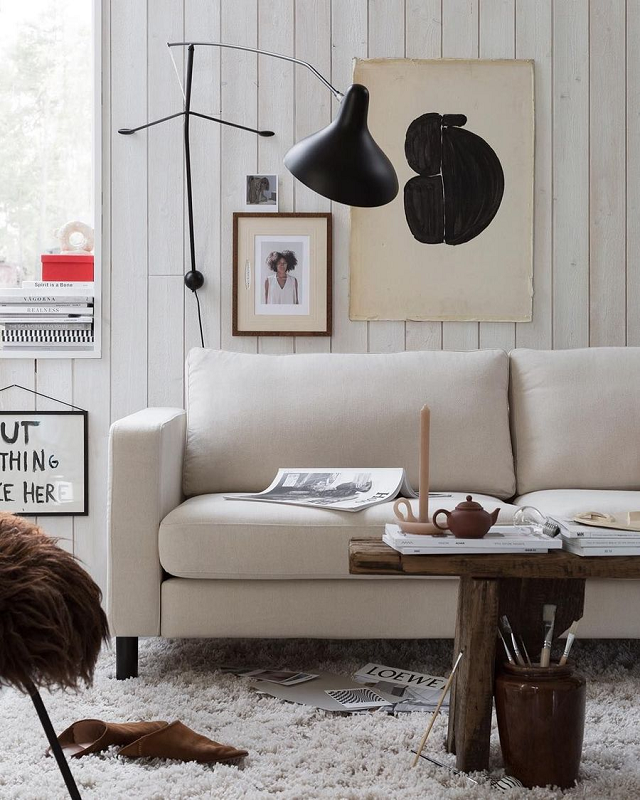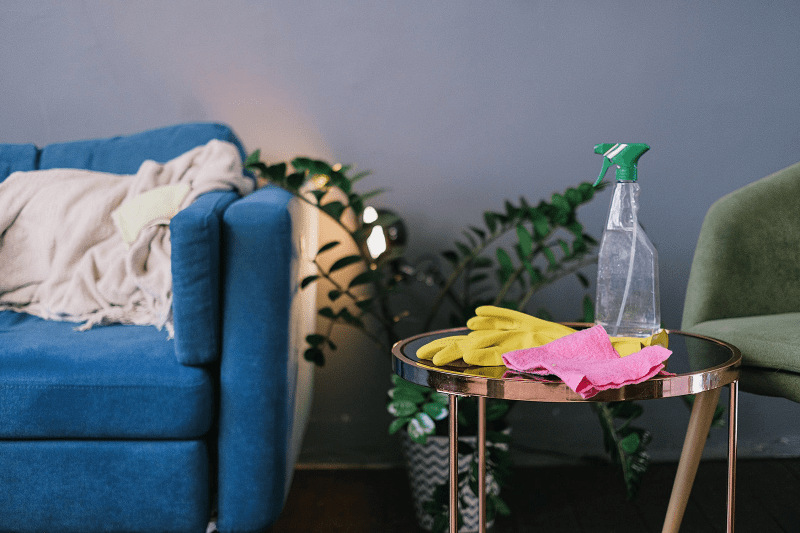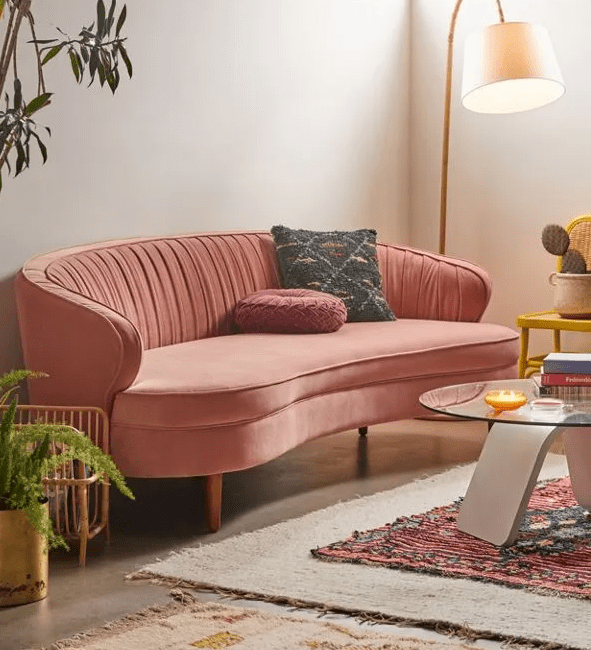Hey there, I’m glad you are here! I’m about to show you the best pro tips to clean sofa upholstery: You see, your sofa is not only a functional piece of furniture but also a centerpiece in your living space. It provides comfort, relaxation, and a gathering place for family and friends. Over time, however, it’s natural for your sofa upholstery to accumulate dirt, stains, and unpleasant odors. Regular cleaning and maintenance are essential to preserve the beauty and longevity of your sofa.

Cleaning your sofa upholstery might seem completecated, but armed with the right knowledge and techniques, you can easily restore its pristine condition. In this comprehensive guide, we will provide you with expert tips, insights, and step-by-step instructions to help you clean various types of sofa upholstery with confidence and effectiveness.
- Pro Tips to Clean Sofa Upholstery at Home
- Products Needed to Clean Your Sofa Upholstery
- Best Homemade Solutions To Clean Sofa Upholstery
- Follow the Cleaning Codes for Fabric Sofas Chart
- How To Remove Toughest Stains
- How to Get Smells Out of Couch Fabric
- How to Deep Clean Fabric and Microfiber Couches
- How to Get Water Stains Out of Fabric Sofa
- How to Disinfect a Sofa
- Do’s and Don’ts of Cleaning Sofa Upholstery At Home
- Conclusion: Tips to Clean Sofa Upholstery
- FAQ’s (Frequently Asked Questions)
- Q: Can I machine wash my fabric sofa covers?
- Q: How often should I clean my sofa upholstery?
- Q: Is it safe to use vinegar to clean leather sofas?
- Q: Can I use baby wipes to clean my fabric sofa?
- Q: How can I prevent pet hair from sticking to my sofa upholstery?
- Q: Can I clean my sofa upholstery with steam?
Pro Tips to Clean Sofa Upholstery at Home

Understanding Your Sofa Upholstery
Before diving into the cleaning process, it’s crucial to understand the type of upholstery you have. Different materials require different cleaning methods and products. Most common sofa upholstery materials include:
- Fabric: Fabric sofas are popular due to their versatility and comfort. They come in various textures, patterns, and colors. Common types of fabric upholstery include cotton, linen, polyester, and microfiber.
- Leather: Leather sofas exude luxury and sophistication. They require specific care to prevent damage and maintain their natural beauty. There are different types of leather, such as full-grain, top-grain, and bonded leather.
- Synthetic Upholstery: Some sofas feature synthetic materials like vinyl or faux leather. These materials mimic the look of genuine leather but have different cleaning requirements.
Now that you have identified your sofa upholstery material let’s explore pro tips for cleaning each type of upholstery.
Also: 7 Ways to Create a Beautiful Color Palette For Your Home
Products Needed to Clean Your Sofa Upholstery
To effectively clean sofa upholstery, you will need a few essential products. The specific products required may vary based on the type of upholstery material. Here are some commonly used items:
- Vacuum Cleaner: A good quality vacuum cleaner with a soft brush attachment is essential for removing loose dirt, dust, and debris from the surface and crevices of your sofa upholstery.
- Mild Detergent: For fabric sofas, a mild detergent is often recommended for spot cleaning or preparing a cleaning solution. Look for a detergent that is gentle and free of harsh chemicals.
- White Cloths or Paper Towels: These are necessary for blotting and removing stains. It’s important to use white cloths to prevent any dye transfer or color bleeding onto the upholstery.
- Upholstery Cleaner: Depending on the type of upholstery, you may need a specialized upholstery cleaner. These cleaners are formulated to effectively clean and remove stains from specific materials like microfiber, cotton, or leather.
- Leather Conditioner: If you have a leather sofa, a high-quality leather conditioner is essential for maintaining its suppleness, preventing drying or cracking, and enhancing its natural shine.
- Baking Soda: Baking soda is a versatile product that can help eliminate odors from fabric sofas. It acts as a natural deodorizer and can be sprinkled over the upholstery and vacuumed off after a few hours.
- Soft Brushes or Microfiber Cloths: Soft-bristled brushes or microfiber cloths are useful for gently scrubbing and cleaning the upholstery without causing any damage.
Also: How To Choose The Right Mood When Decorating My Home
It’s important to note that the specific products needed may vary depending on the type of sofa upholstery you have and any specific cleaning instructions provided by the manufacturer. Always refer to the care labels and follow the recommendations to ensure the best cleaning results without causing any harm to your sofa upholstery.
Best Homemade Solutions To Clean Sofa Upholstery
If you prefer using homemade solutions to clean your sofa upholstery, there are several effective options you can try. These solutions are often gentle, cost-effective, and environmentally friendly. Here are a few homemade solutions that can work wonders on various types of sofa upholstery:
- Vinegar and Water Solution: Mix equal parts of white vinegar and water in a spray bottle. This solution can be used for fabric sofas to remove general dirt and stains. Test it on a small, inconspicuous area first to ensure it doesn’t cause any discoloration or damage.
- Baking Soda and Water Paste: Create a paste by mixing baking soda with water until it forms a thick consistency. Apply the paste to fabric sofas to tackle tough stains. Gently scrub the stained area with a soft brush or cloth, then wipe away the residue with a damp cloth.
- Dish Soap and Warm Water Solution: For fabric sofas, you can create a mild cleaning solution by mixing a few drops of dish soap with warm water. Dip a clean cloth into the solution, wring out excess moisture, and gently blot or wipe the stained areas. Rinse with a damp cloth and let it air dry.
- Lemon Juice and Cream of Tartar: Make a paste by mixing equal parts lemon juice and cream of tartar. This mixture can be used to remove stains from light-colored fabric upholstery. Apply the paste to the stain, let it sit for a few minutes, then gently scrub with a soft brush. Rinse with a clean, damp cloth.
- Olive Oil and Vinegar Polish: For leather sofas, you can create a natural polish by combining equal parts olive oil and white vinegar. Dip a clean cloth into the mixture, wring out excess liquid, and gently buff the leather surface in circular motions. This helps moisturize and restore the shine of the leather.
Remember to always test homemade solutions on a small, hidden area of your sofa upholstery before applying them to the entire surface. This will help ensure compatibility and prevent any potential damage. Additionally, it’s crucial to blot or wipe the upholstery rather than saturating it with excessive moisture to avoid potential water damage.
Follow the Cleaning Codes for Fabric Sofas Chart
Fabric sofas often come with cleaning codes that provide guidelines on the appropriate cleaning methods and solutions. Here is a chart explaining the common cleaning codes you may encounter:
- W: Water-based cleaning agents or mild detergents are safe to use.
- S: Only solvent-based cleaners are recommended. Avoid water-based solutions.
- SW: Either water-based or solvent-based cleaners can be used.
- X: Only vacuuming or light brushing is recommended. No liquids or solvents should be used.
Consult the manufacturer’s guidelines or the sofa’s documentation to determine the specific cleaning code for your fabric sofa. Adhering to the correct cleaning method will help maintain the quality and appearance of your upholstery while avoiding any potential damage.
Also: A Pro Guide To Best Interior Paint Finishes For Walls
By following these guidelines, you can effectively address smells, deep clean fabric and microfiber couches, remove water stains, disinfect your sofa, and understand the cleaning codes for fabric sofas. Regular maintenance and prompt action will ensure that your sofa upholstery remains fresh, clean, and inviting for years to come.
“If you are looking for a way to style your space with wall art without breaking your piggy bank, then I recommend reading “10 Surprising Benefits of Printable Wall Art”
Pro Tips for Cleaning Fabric Sofas

- Vacuum Regularly: Begin by vacuuming your fabric sofa to remove loose dirt, dust, and debris. Use a soft brush attachment to avoid damaging the fabric.
- Check the Label: Refer to the manufacturer’s instructions or cleaning label attached to your sofa. It provides important information about suitable cleaning methods and any specific cleaning codes to follow.
- Blot Stains Immediately: If a spill occurs, act quickly and blot the stain with a clean, white cloth or paper towel. Avoid rubbing, as it can spread the stain and damage the fabric.
- Spot Cleaning: For minor stains, prepare a homemade solution by mixing mild detergent with warm water. Test the solution on a hidden area first and then gently dab the stain using a clean cloth. Rinse with a damp cloth and let it air dry.
- Deep Cleaning: Once in a while, give your fabric sofa a thorough deep clean. You can use a steam cleaner or hire professional upholstery cleaning services for effective results.
- Odor Removal: To eliminate odors from your fabric sofa, sprinkle baking soda over the surface and let it sit for a few hours. Vacuum the sofa afterward to remove the baking soda along with any unpleasant odors.
Pro Tips for Cleaning Leather Sofas

- Gentle Dusting: Begin by dusting your leather sofa regularly using a soft, dry cloth or a vacuum cleaner with a soft brush attachment. This step removes surface dust and prevents it from settling into the leather pores.
- Leather Conditioning: Apply a high-quality leather conditioner to keep your sofa supple and prevent it from drying out or cracking. Follow the product instructions for the best results.
- Handling Spills: In case of spills, blot the liquid immediately using a clean, absorbent cloth. Avoid using excessive water or rubbing, as it can damage the leather. If necessary, use a slightly damp cloth for gentle cleaning.
- Avoid Harsh Chemicals: When cleaning your leather sofa, avoid using harsh chemicals, such as bleach or ammonia-based cleaners. Stick to mild, pH-neutral leather cleaners recommended for your specific type of leather.
- Sunlight Protection: Place your leather sofa away from direct sunlight to prevent fading and drying. Excessive exposure to sunlight can cause the leather to crack or lose its color.
- Professional Cleaning: Consider professional leather sofa cleaning services at least once a year for a deep cleanse and to maintain its luxurious appeal.
How To Remove Toughest Stains
Stubborn stains on sofa upholstery can be quite frustrating, but with the right approach, they can be effectively removed. Of all the tips to clean sofa upholstery, this is one you want to remember. Here are some specific methods to tackle common stubborn stains:
- Red Wine Stains: Blot the stain immediately with a clean cloth or paper towel to absorb as much wine as possible. Mix a solution of one part dish soap and two parts hydrogen peroxide. Apply the solution to the stain and gently blot with a cloth. Rinse with water and blot dry.
- Pen or Marker Stains: Dab the stain with rubbing alcohol using a clean cloth or cotton ball. Blot gently, taking care not to spread the ink. Repeat as necessary until the stain lifts. Once removed, clean the area with mild soap and water, then blot dry.
- Chewing Gum: To remove chewing gum from upholstery, apply ice cubes in a plastic bag directly onto the gum to harden it. Once hardened, gently scrape off the gum with a plastic scraper or a blunt knife. Clean the area with a mild detergent solution and blot dry.
- Traces of Fat: For grease or fat stains on fabric upholstery, sprinkle cornstarch or talcum powder over the stain and let it sit for a few hours to absorb the grease. Vacuum or brush off the powder, then treat the area with a mild dish soap and water solution. Blot dry.
- Blood Stains: Act quickly by blotting the blood stain with a cloth soaked in cold water. Avoid using hot water, as it can set the stain. Create a paste by mixing cornstarch or baking soda with cold water and apply it to the stain. Let it dry, then brush or vacuum off the residue. If the stain persists, use hydrogen peroxide in small amounts, followed by blotting with cold water and drying.
- Vegetable or Fruit Juice: Blot the stain immediately with a clean cloth or paper towel to remove excess liquid. Mix a solution of equal parts water and white vinegar. Apply the solution to the stain and gently blot with a cloth. Rinse with water and blot dry. For stubborn stains, you can also try using a mild dish soap and water solution.
It’s important to test any cleaning method on a hidden area of your sofa upholstery first to ensure it doesn’t cause discoloration or damage. Additionally, always blot stains gently rather than rubbing, as rubbing can further embed the stain into the fabric.
How to Get Smells Out of Couch Fabric
Unpleasant odors can linger in couch fabric, making it essential to know how to eliminate them effectively. Here are a few methods to help you get rid of unwanted smells:
- Baking Soda: Sprinkle baking soda liberally over the fabric and let it sit for several hours or overnight. Baking soda is a natural deodorizer that helps absorb odors. Vacuum the baking soda thoroughly to remove both the powder and the trapped smells.
- White Vinegar Solution: Mix equal parts of white vinegar and water in a spray bottle. Lightly mist the fabric surface, ensuring not to saturate it excessively. Vinegar is known for its odor-neutralizing properties. Allow the fabric to air dry, and the vinegar smell will dissipate, taking the unpleasant odors with it.
- Fabric Freshener Spray: Commercial fabric fresheners are designed to eliminate odors from upholstery. Follow the instructions on the product and apply it evenly across the fabric. These sprays often leave a pleasant scent behind while neutralizing the existing odors.
Also: Step-by-Step Guide to Declutter Your Home
Always spot test any cleaning solutions or fresheners on a small, inconspicuous area of the fabric before applying them to the entire couch to avoid any potential discoloration or damage.
How to Deep Clean Fabric and Microfiber Couches

Deep cleaning fabric and microfiber couches can revive their appearance and remove embedded dirt and stains. Follow these steps for a thorough deep cleaning:
- Vacuuming: Use a soft brush attachment to vacuum the entire couch, including the cushions, to remove loose dirt and debris.
- Stain Removal: Identify any visible stains and treat them individually. Use a suitable stain remover or a mixture of mild detergent and water. Apply the solution to a clean cloth and gently blot the stains. Avoid rubbing vigorously, as it can spread the stain or damage the fabric.
- Steam Cleaning: If your couch allows it, steam cleaning can be highly effective for deep cleaning fabric and microfiber upholstery. Follow the manufacturer’s instructions on the steam cleaner and ensure you’re using the appropriate cleaning solution. Steam the fabric surface evenly, working in sections, and allow it to dry thoroughly.
- Drying: Proper drying is crucial to prevent mold and mildew growth. Ensure that the couch is placed in a well-ventilated area with good airflow. You can use fans or open windows to expedite the drying process.
How to Get Water Stains Out of Fabric Sofa
Water stains on fabric sofa can be unsightly, but they can often be treated effectively. Here’s how to remove water stains from your couch:
- Blotting: Immediately after the spill occurs, use a clean cloth or paper towel to blot the water stain gently. Avoid rubbing, as it can push the water further into the fabric.
- Drying: Allow the fabric to air dry naturally. Do not use excessive heat sources like hairdryers, as they can cause the stain to set or damage the fabric.
- Vinegar Solution: If the water stain persists, mix equal parts of white vinegar and water. Dampen a clean cloth with the solution and gently blot the stain. Rinse the cloth with clean water and blot the area again to remove any residue. Allow it to air dry.
- Steam Cleaning: For stubborn water stains, steam cleaning can be effective. Use a steam cleaner with appropriate attachments for fabric upholstery and follow the manufacturer’s instructions. Steam the stained area evenly, allowing the fabric to dry completely afterward.
How to Disinfect a Sofa

Disinfecting your sofa is essential, especially if it’s exposed to germs, allergens, or odors. Follow these steps to effectively disinfect your sofa:
- Vacuuming: Use a vacuum cleaner with upholstery attachments to remove loose dirt, dust, and debris from the surface and crevices of the sofa.
- Disinfecting Solution: Prepare a disinfecting solution by mixing a suitable disinfectant with water according to the manufacturer’s instructions. Choose a disinfectant that is safe for use on your specific upholstery material.
- Spot Test: Before applying the disinfecting solution to the entire sofa, spot test it on a small, inconspicuous area to ensure it doesn’t cause any discoloration or damage.
- Application: Spray or apply the disinfecting solution evenly over the fabric, ensuring thorough coverage. Pay extra attention to high-touch areas such as armrests and cushions.
- Drying: Allow the sofa to air dry completely. Open windows or use fans to expedite the drying process.
Also: 15 Best Tips to Stage Your Home to Sell Faster
Don’t forget to always read and follow the instructions on the disinfectant product to ensure safe and effective use.
Do’s and Don’ts of Cleaning Sofa Upholstery At Home

Cleaning your sofa upholstery at home requires proper care and attention to ensure the best results without causing damage. Here are some important do’s and don’ts to keep in mind:
Do’s:
- Read the Manufacturer’s Instructions: Before starting any cleaning process, carefully read the manufacturer’s instructions or guidelines specific to your sofa upholstery. This will provide valuable information on recommended cleaning methods, suitable cleaning products, and any specific precautions to take.
- Vacuum Regularly: Regular vacuuming helps remove dust, dirt, and debris from the surface and crevices of your sofa upholstery. Use a soft brush attachment to avoid scratching or damaging the fabric.
- Blot Spills Immediately: If a spill occurs, act quickly and blot the affected area with a clean cloth or paper towel. Blotting helps absorb the liquid before it seeps into the fabric and creates a stain.
- Use Mild Cleaning Solutions: When spot cleaning stains, use mild cleaning solutions or specialized upholstery cleaners recommended for your specific fabric type. Always perform a spot test on an inconspicuous area first to ensure the solution doesn’t cause any discoloration or damage.
- Follow Proper Techniques: When cleaning, use gentle motions and avoid rubbing or scrubbing vigorously, as this can push stains deeper into the fabric or damage the fibers. Blotting or dabbing is usually the preferred technique.
Don’ts:
- Avoid Harsh Chemicals: Harsh chemicals such as bleach, ammonia, or strong detergents can damage the fabric and cause discoloration. Avoid using these substances unless specifically recommended by the manufacturer.
- Don’t Oversaturate: Whether using water-based or solvent-based cleaners, avoid oversaturating the fabric. Excessive moisture can lead to long drying times, water stains, or even mold and mildew growth. Follow the instructions and use the recommended amount of cleaning solution.
- Don’t Use Excessive Heat: Avoid using excessive heat sources, such as hairdryers or direct sunlight, to speed up the drying process. High heat can damage certain upholstery materials and cause them to shrink or warp.
- Don’t Remove Cushion Covers Unless Necessary: Unless specifically designed to be removed and washed, avoid removing cushion covers for cleaning. Some upholstery fabrics may not be machine washable, and improper removal or washing can lead to shrinkage or damage to the covers.
- Don’t Skip Regular Maintenance: Regular maintenance is crucial for keeping your sofa upholstery clean and prolonging its lifespan. Don’t neglect routine vacuuming, spot cleaning, and occasional deep cleaning to prevent dirt buildup and stains from setting.
Also: 15 First Steps to Creating a Decorating Plan
By following these do’s and don’ts, you can effectively clean your sofa upholstery at home while minimizing the risk of damage. Remember, if you’re unsure about the proper cleaning method or have concerns about specific stains or upholstery materials, it’s always best to consult a professional upholstery cleaner for expert advice and assistance.
Most Popular Post:
10 Surprising Benefits of Printable Wall Art
15 Must-Have Accessories For Styling A Coffee Table
How to Choose the Perfect Interior Color Scheme for Your Home
Expert Guide On How To Buy A Rug For Each Room
Conclusion: Tips to Clean Sofa Upholstery
Maintaining clean and fresh sofa upholstery is essential for both the aesthetic appeal and longevity of your furniture. By following the pro tips and techniques outlined in this comprehensive guide, you can confidently tackle dirt, stains, and odors, ensuring that your sofa remains a comfortable and inviting centerpiece in your home.
Regular maintenance, including weekly vacuuming and prompt spot cleaning, is the first line of defense against dirt and debris buildup. By staying proactive and addressing spills and stains as soon as they occur, you can prevent them from setting and becoming more challenging to remove.
For deeper cleaning, understanding the specific requirements of your upholstery material is crucial. Fabric sofas may benefit from steam cleaning or using mild detergent solutions, while leather sofas require specialized cleaners and conditioners to preserve their natural beauty. By adhering to the manufacturer’s recommendations and guidelines, you can ensure that your cleaning methods are safe and effective.
When faced with stubborn stains, the key is to act quickly and use the appropriate techniques. From red wine and ink stains to chewing gum and traces of fat, each stain requires a specific approach. By following the step-by-step instructions provided in this guide, you can effectively remove even the toughest stains, restoring your sofa upholstery to its original glory.
To protect and maintain your sofa upholstery, consider implementing preventive measures. Using protective covers can help shield your upholstery from daily wear and tear, especially if you have pets or young children. Additionally, regular conditioning and treatments for leather sofas will keep them supple, prevent cracking, and enhance their natural luster. I hope you enjoyed this guide on pro tips to clean sofa upholstery, feel free to read my other post.
FAQ’s (Frequently Asked Questions)
Q: Can I machine wash my fabric sofa covers?
A: It depends on the care instructions provided by the manufacturer. Some fabric covers are machine washable, while others require professional cleaning or spot treatment.
Q: How often should I clean my sofa upholstery?
A: Regular cleaning and maintenance are recommended to prevent dirt build-up and maintain the appearance of your sofa upholstery. Vacuuming and spot cleaning should be done weekly, while deep cleaning can be performed every 6-12 months.
Q: Is it safe to use vinegar to clean leather sofas?
A: It’s best to avoid using vinegar or any acidic solutions on leather sofas. Acidic substances can damage the protective finish and cause discoloration. Stick to pH-neutral leather cleaners for safe and effective cleaning.
Q: Can I use baby wipes to clean my fabric sofa?
A: Baby wipes may contain additives and chemicals that can leave residues on your fabric sofa. It’s safer to use a mild detergent solution or consult the manufacturer’s recommendations for cleaning.
Q: How can I prevent pet hair from sticking to my sofa upholstery?
A: Regularly brush and groom your pets to minimize shedding. Covering your sofa with a washable pet-friendly blanket or using a pet hair removal tool can also help prevent pet hair from sticking to the upholstery.
Q: Can I clean my sofa upholstery with steam?
A: Steam cleaning can be effective for deep cleaning fabric sofas. However, it’s essential to follow the manufacturer’s recommendations and avoid excessive moisture, as it can damage certain fabrics.
CATCH THE LATEST IN HOME DECOR TRENDS:

Steal These 15 Expert-Approved Decorating Secrets

How To Accessories Your Living Room

Small Space? 10 Ways To Make A Room Appear Bigger

Make Your space Look Expensive
GET CAUGHT UP ON ALL THE INSPIRING DECOR TIPS:

18 Fresh Decorating Ideas To Update Your Fireplace

How To Create An Art Gallery Wall

